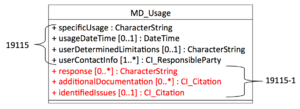Difference between revisions of "Resource Specific Usage"
From Earth Science Information Partners (ESIP)
(Created page with "Capturing information from users about how they are using data and limitations that they identify with specific products is an important part of the on-going process of docume...") |
|||
| Line 1: | Line 1: | ||
Capturing information from users about how they are using data and limitations that they identify with specific products is an important part of the on-going process of documenting information quality. The ISO metadata standards (19115 and 19115-1) both include standard mechanisms for representing this kind of information. This page focuses on 19115-3 which includes and extends the 19115 approach. | Capturing information from users about how they are using data and limitations that they identify with specific products is an important part of the on-going process of documenting information quality. The ISO metadata standards (19115 and 19115-1) both include standard mechanisms for representing this kind of information. This page focuses on 19115-3 which includes and extends the 19115 approach. | ||
=Conceptual Model= | =Conceptual Model= | ||
| + | [[File:MD Usage UML.png|thumb|MD_Usage Object]] This Figure shows the MD_Usage object with the properties included in 19115 in black and those from 19115-1 in red. | ||
=MODIS Atmosphere Validation= | =MODIS Atmosphere Validation= | ||
Revision as of 15:51, May 2, 2014
Capturing information from users about how they are using data and limitations that they identify with specific products is an important part of the on-going process of documenting information quality. The ISO metadata standards (19115 and 19115-1) both include standard mechanisms for representing this kind of information. This page focuses on 19115-3 which includes and extends the 19115 approach.
Conceptual Model
This Figure shows the MD_Usage object with the properties included in 19115 in black and those from 19115-1 in red.
